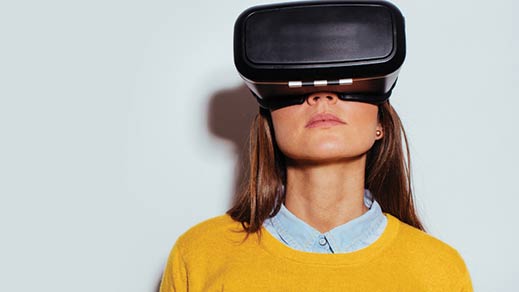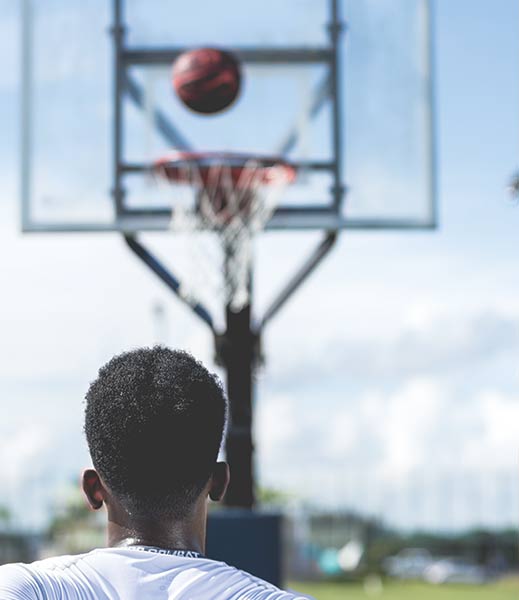The many dimensions of virtual reality
Expert reviewers
Essentials
- Virtual reality (VR) has a serious side in education, training, social communication and psychological therapy.
- VR can change human behaviour.
- VR experiences can affect people physically, emotionally and socially.
- While VR experiences may be ‘fake’, the emotions experienced are ‘real’.
If a picture is worth a thousand words, then an experience, even a digital one, seems to be worth many more.Heather Millar, Stanford
It seems that virtual reality is everywhere lately—in the news, on department store shelves… even in the doctor’s office. What began as the plaything of gamers is maturing into a potentially very useful and multi-faceted technology. One that not only has the ability to help treat a range of mental afflictions, from anxiety to post-traumatic stress disorder, but also improve our athletic ability and, just maybe, help us to become more empathetic and responsive humans. Don’t believe me? Read on…

What is virtual reality?
Virtual reality (VR) can be defined as an immersive, computer-generated three-dimensional (3D) environment. Depending on the quality of the system, users can see, hear, smell, interact with and affect their surroundings. More about the technology of VR.
An effective VR experience enables users to temporarily forget the ‘real’ world and instead feel a part of the virtual world they are experiencing.
Improving mental health
I’m sitting at my desk. In front of me is my computer, phone…and a large brown spider. I’m looking at him, his eight eyes are looking straight at me. I take a deep breath. His legs twitch as he starts to crawl towards my outstretched hand….
It may sound like a scenario from a horror movie, but situations like this, while not common in everyday life (thankfully!) are becoming increasingly available to people via virtual reality. Why, you may ask, would anyone want this reality?
It’s a technique called exposure therapy (ET) and it has been used by clinicians for decades as a way to manage and treat mental health conditions such as phobias, anxiety and post-traumatic stress disorder (PTSD). Previously, it involved a patient talking through their fears and gradually being exposed to them in a controlled way (for example progressing from looking at a picture of a spider to eventually holding one).

Virtual reality exposure therapy (VRET) builds on this technique. While VR has been used by therapists for decades, rapid advancements in the technology over the last few years have made it a more accessible and useful tool in the medical kit bag.
Modern VR technology can create tailored, realistic and most importantly controllable experiences in the safety of your clinician’s office. This has several advantages. Firstly, the doctor can monitor, record or manipulate the experience at any time. For example they can pause it to discuss coping strategies, or progress you to the next level if you’re managing well. Secondly, the technology can cater for a whole suite of mental health issues, all without the patient having to leave the building.
VR applications have been shown to reduce fear, manage eating disorders, deal with post-traumatic stress disorder and reduce treatment-induced pain in burn victims. An 'intelligent' and human-like virtual counsellor has also been trialled which provides users with easy access to healthcare and stress-reduction advice via smart phones, enabling them to obtain real-time support. These bodies of research demonstrate that VR applications can be considered as positive technology tools.
It works for two reasons. Firstly, an effective VR experience essentially hijacks the brain in to thinking that it’s ‘real’, and can bring out real emotions and feelings. Researchers have found that these emotions can remain with the participant after the simulation has finished, at least for a short while, and can translate back into real world situations. So practising getting in a virtual lift can, over time, help you to eventually be able to enter its real-life equivalent. The tailored VR simulation can essentially imprint the memory of that experience into the brain, and then, when you are actually confronted with that experience in the real world, you already have a ‘memory’ of how you dealt with it.
Secondly, it works because our brain is incredibly adaptable, and can be ‘retrained’ to alter its response to fear. By deliberately and repeatedly exposing the brain to fearful situations (a process known as habituation), we can teach the frontal cortex (the thinking part of the brain) to be less reactive to the amygdala (the fear-processing part of the brain) so over time the sense of fear is reduced.
This is important because the technology is not eliminating the fear or supressing a traumatic memory, but helping the patient to learn to manage it, to change the way they experience and respond to the emotion. The memory is maintained without the emotional intensity attached to it.
And in relation to using VR to reduce pain, it’s based on the theory that the human brain has a limited capacity for conscious awareness. So if your focus and attention is on a very immersive and compelling VR world, your brain has less attention left over to focus on and register pain.
However, there is a catch. To trick the brain, the experiences need to be immersive enough to achieve a sense of ‘presence’—that is—a feeling like you’re really in the virtual world to such an extent that you forget about the ‘real world’ around you. Research has shown that level of presence corresponds to the strength of emotions and feelings experienced in the VR setting.
So the spider, the lift or even the wartime scenario does not have to look 100 per cent photo-realistic, but the experience as a whole (visuals, sounds, possibly touch) has to be enough to promote real-world feelings and to immerse you in the experience.

As well as assisting burn victims undergoing treatment, VR technology is also being trialled in assisting patients who suffer from chronic pain as an alternative to drug-based interventions. In trials, patients exposed to immersive VR experiences reported reduced pain levels and a reduction in levels of distress and discomfort. Investigators hypothesise that ‘VR acts as a nonpharmacologic form of analgesia by exerting an array of emotional affective, emotion-based cognitive and attentional processes on the body’s intricate pain modulation system.’
Even short bursts of a relaxing VR simulation—for example five minutes experiencing a beach scene or standing in a quiet forest—can reduce stress-levels. This can be useful for students at exam time, through to people suffering from dementia.
While the technology does not replace the need for a trained mental health expert (particularly in the treatment of more serious mental issues), it adds to treatment options.
App developers have seen this trend and have been quick to jump on board. There are now various mental health-related VR apps available to download for people who have VR technology on their phone or in their homes. These apps can deliver scenarios to help people overcome certain phobias, or provide relaxing, meditative experiences to reduce anxiety levels.
While these apps have the advantage of being available for use at any time, without the need for a doctor’s appointment, they are unregulated and generally not backed by scientific research. Consumers should take with a grain of salt any claims the apps make that they will benefit or improve users’ mental health.
Sports training
It’s not only the medical profession that can benefit from VR. Indeed, it’s already being used by a range of athletes across multiple sporting codes to support and enhance their on-field training.
Just as there are many different sports, there are a range of varied VR technologies aimed at athletes, from simulated cycle routes (your bike set up in front of a screen where you compete against others) to full-immersion headset technology. The complexity of the system depends on the needs of the athlete … and the money available to create the simulation.
At the top end of the spectrum is the National Football League (NFL) in the US. As a well-funded code, it was one of the early adopters of the technology. The specially-designed simulations are created via 360 filming taken during on-field training sessions. This is then played back to athletes via VR headsets, allowing them to watch plays over and over again from a first-person point of view. This repetition can assist players to improve their reaction times and technique, enhance ‘in-the-moment’ decision making, and strengthen their capacity to recognise patterns (such as field formations). It also allows second-string and younger players to get ‘on-field’ experience and to view specific parts of the team in play.
Other sports that have embraced VR include golf, basketball, cycling, hockey and soccer. Even fans and non-professional athletes can benefit from the technology, with VR programs allowing them to sit courtside at games, or improve their own technique through commercially-available VR applications.

Because the technology is still developing, there are not yet any scientific studies that prove or disprove the long-term usefulness of VR technology for athletes. Comments by athletes who have used the technology however, have been generally positive. As the technology becomes more common, proper evaluation will no doubt follow. Of course, VR will never fully replace on-field training and all the physicality that goes with it, but as the technology improves it will potentially play an important additional role in the elite athlete’s training regime.
Using VR to…save the world?
Of all the proposed uses for VR, the one that might be most exciting (or at least, the most beneficial) is it’s potential to make us more empathetic, more socially conscious, or, put more simply, to just make us better people.
Stanford University’s Virtual Human Interaction Lab has been studying the psychology of VR for nearly 20 years. They have conducted a range of studies to try and determine the effect VR has on the user, including its ability to encourage empathetic, pro-social behaviour and effect positive change.
The Walk a Mile in Digital Shoes study gave users the ability to look in a virtual mirror and see reflected back another person, for example, someone with different skin colour, age, gender, or ability. The results demonstrated varying effectiveness of VR in teaching empathy, in particular that negative stereotyping of the elderly (at least immediately after the VR experience) ‘was significantly reduced when participants were placed in avatars of old people…’ .
Another study undertaken by the VHIL found that participants who cut down a virtual tree within an immersive virtual environment used 20 per cent less paper after the experience, with the increase in environmentally-positive behaviour lasting for up to a week after the simulation. Other participants who took a VR shower while watching their avatar eating coal to represent the energy being used went on to use less water in real life after the experience. Exactly how long these positive effects last however, has not been established.
Most people cannot travel to see the destruction of the Amazon or scuba the Great Barrier Reef to view coral bleaching, but these realities can be brought to real and vivid life through the world of VR. From climate change to ocean acidification, deforestation and pollution, VR can offer participants a first-hand glimpse at the threats facing the environment today.

VR could also prompt people to help themselves, for example by saving more for their retirement. Participants who were presented with an aged avatar of themselves in the VR world later allocated significantly more money towards their superannuation accounts in a retirement savings questionnaire. It’s as if the act of seeing their future selves was a wakeup call that they would, indeed, grow old, and something they needed to prepare for.
While many of these studies show positive results, we shouldn’t get too excited just yet. Small sample sizes, limited follow up review and the restricted range of scenarios available mean further studies need to be undertaken to assess the long-term effects (if any) of the experiences.
So, while VR may not be able to save the world, if it can encourage a person to act more kindly towards others, take steps to reduce their environmental impact or improve their own future, then at least that’s a start.
Where to from here?
While exciting, the use of VR technology in treating mental health, improving athletic ability and changing our social behaviour still has a long way to go. There are several hurdles that need to be overcome.
- The cost of the technology, while trending down, is still very cost-prohibitive, particularly in the development of content. Some of the technology is also hard to set up and maintain if a user is not technically minded.
- Many simulations are passive, where the user is watching an experience but not able to directly influence it.
- Developing individually tailored, interactive VR, where an athlete can hit a ball or a person can choose their own path to follow in an experience, is the next step.
- More high-quality content needs to be created to meet the demand of the growing industry.
Virtual reality is an exciting, evocative technology with a lot of potential. While rationally a user may know the experience is simulated, the brain does not necessary make that distinction. So doing something in the VR world—whether it be conquering a fear, watching a game play or cutting down a tree—can create memories that are both realistic and possibly lasting. Once the headset is off, those feelings and memories remain, and can continue to affect you and the way you interact with the world around you. As the technology continues to improve and our understanding of how it affects us physically, mentally and emotionally is further established, we will see VR become more accessible and used in more aspects of our lives.





